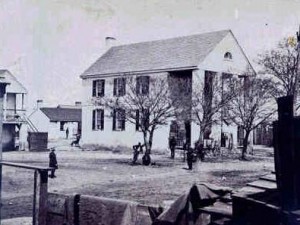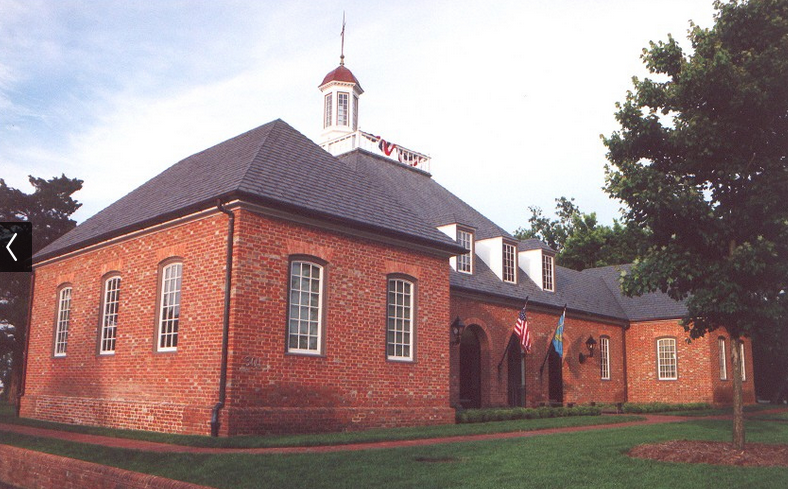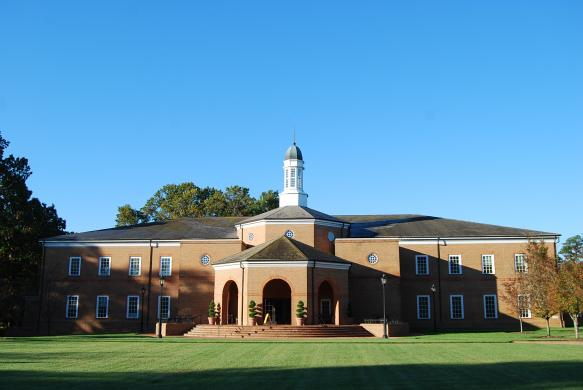PRESERVATION OF EARLIER RECORDS
The following is an excerpt from a newspaper article by Donald S. Knight published on Sunday morning, November 13, 1955.
HISTORY OF EARLIER RECORDS
Sheild, however, was not alone as a clerk of courts who placed the safety of his books first in the line of duty.
History, sweeping in a never ending current around the community for two centuries and nearly always directing a destructive finger of seige, fire and explosion towards the courthouse, reveals that there were other dark days for previous clerks.
These public servants, their names seen today as illegible scrawls on their own records, have managed to be just one step ahead of those many dangers.
Most often the clerk of courts was quartered in a separate structure on the courthouse property, designated as Lot 24 in county land books, and in most cases these tiny buildings offered only minimum protection against the threat of war or lesser danger.
Special reports on file in the National Park Service library at Yorktown reveal that the first Colonial clerks for the county conducted business from their homes.
It wasn’t until 1707 that the county magistrates contracted with a William Buckner to build an office-at a cost of 6,000 pounds of tobacco.
By this date the first of five York courthouses, a frame, one-story building, had been erected at the corner of what is now Main and Ballard Streets. Buckner’s contract specified that the clerk’s new headquarters adjoin the porch of this building.
STANDING IN 1730
It was 16-foot square, construct of feather-edged planking and records indicated it was still standing by 1730 when the condition of the main courthouse created a demand for a new and larger meeting place for the county magistrates.
The second courthouse project was undertaken in 1733 but no new clerk’s office was included in the plan. The last known reference to the original office was made in 1746 when a court order was entered by the clerk to repair to office windows. Between 1746 and 1808, then, this office was abandoned and it is assumed the clerk moved his books, for the first time, into the courthouse. Records of the large building reveal it was spacious enough to accommodate the clerk in either wing.
During this period, too, the first evacuation to insure the safety of the county records were carried out by a Colonial clerk. In 1777, with the British erecting their fortifications around the town, they were carried to Richmond-probably by a water and land route.
It may have been his knowledge of this deed that prompted Sheild to devise a similar plan nearly 100 years later.
When Cornwallis’ legion arrived for the crucial battle at Yorktown they chose the courthouse as a base of operations. Later, the French forces occupied the building.
BOOKS RETURNED
Such was the state of affairs of Lot 24 during this period that the clerk of court, his books returned from Richmond by court order, reported that the magistrates for the county attempted to hold court in the building but “a variety of disorder within and the disagreeable smell of the house deterred the gentlemen for going in …..”
By 1808, however, conditions had apparently improved and on July 18 the clerk noted completion of a remodeling project and his entry indicated that a need for more space in the building for court sessions had forced him to remove his books once again to separate quarters.
On this day the court ordered the second clerk’s office erected, this time at a cost of $540. Actual remains of this building were uncovered in the government’s archaeological project on the site.
Insurance papers for this building show it was also built adjacent to the courthouse and was move spacious than the first. It had a fireplace on one end-the same fireplace that would warm Bolivar Sheild may winters later.
But the books did not remain on new shelves for long.
In 1812 “they were removed to the house of the clerk,” a court entry shows, “as long as the British fleet infected the York River.”
It must have been fate, or intuition of sorts, that withheld a court order for return of the books to the courthouse scene until Aug. 21, 1815.
WORST DISASTER
Had they been located on Lot 24 during the afternoon of March 3, 1814, they probably would have been damaged if not destroyed. On that day Yorktown witnessed perhaps its worst disaster in an already stormy past.
It was six days before a Richmond paper carried the first brief dispatch of the incident from Yorktown.
“About 3 P.M.,” it read, “Mrs. Gibbons house took fire and together with the court house, the church, the spacious dwelling and the whole of the town below the hill was consumed.”
It was a tragic finish for the magnificent structure that had been erected as a cost in levies amounted to 122,657 pounds of tobacco and had withstood the shock of siege in the Revolution.
Repairs were made to the clerk’s office but the county justices were unable to meet in the fire-gutted courthouse and until 1818 convened at their homes instead.
Yorktown’s third courthouse was an event finer production than its predecessors. Many records and finding, resulting from the Park Service’s 1941 project, today furnish a full account of its appearance and history. It is the first courthouse structure to be captured on camera thanks to the famed Civil War photographer Matthew Brady.

1818 York County Courthouse photographed by Matthew C. Brady in 1863
EXPLOSION WRECKED
But this building proved no more immune from disaster than its earlier counterparts and was totally wrecked by the explosion of Federal ammunition of 1863.
Twelve years passed before the citizens of Yorktown felt they could muster enough finances to erect another building.
On Aug. 24, 1875, the Board of Supervisors contracted to build the fourth county courthouse for $5,865.
But in keeping with tradition the board failed to allot space in this building for the clerk and once again, the records, long since returned from the hiding place on the Mattaponi, were housed in a small separate building near the same spot where the Sheild office had stood.
When this tiny, stucco building also became cramped for space the supervisors agreed to add a fireproof vault on the west end of the building. All of the oldest court records, including those saved by Sheild, were moved into this addition.
The need for such a vault may have been realized several years before when defective heating apparatus caused the fourth courthouse to be gutted by fire on the night of Dec. 31, 1940. The clerk’s office was saved in this catastrophe.
Many years passed before York was ready to dig in again on Lot 24 and it was during this period that the Park Service obtained permission to raze the burned courthouse and conduct its four-month excavation project on this site.
NEW PLANS DRAWN
New courthouse plans were finally drawn but delayed during World War II. After the much debate in the post war years they were submitted to a contractor in the summer of 1954.
The fifth courthouse, the finest to stand on the historic corner lot in Yorktown, is about complete and the clerk of courts, Melville Bryant, had moved the old books into a spacious foot-thick and steel vault in the new structure.
 Built in 1955
Built in 1955
A few days after the old stucco building was abandoned work crews quickly removed this last trace of a 75-year period in Yorktown history for Lot 24.
In an case it is not difficult to imagine that if Bolivar Sheild, or the likes of him that have held this county post during the centuries, should by some miracle be able to walk again across the familiar courthouse lot, he would find a peace of mind that escaped him in this day.
For the old books, ledgers of life during three centuries in York, are safe and secure as never before.
CURRENTLY
The records rescued by Bolivar Sheilds are now housed in the Office of the Clerk of Courts, 300 Ballard Street, Yorktown.
 Built in 1997
Built in 1997
